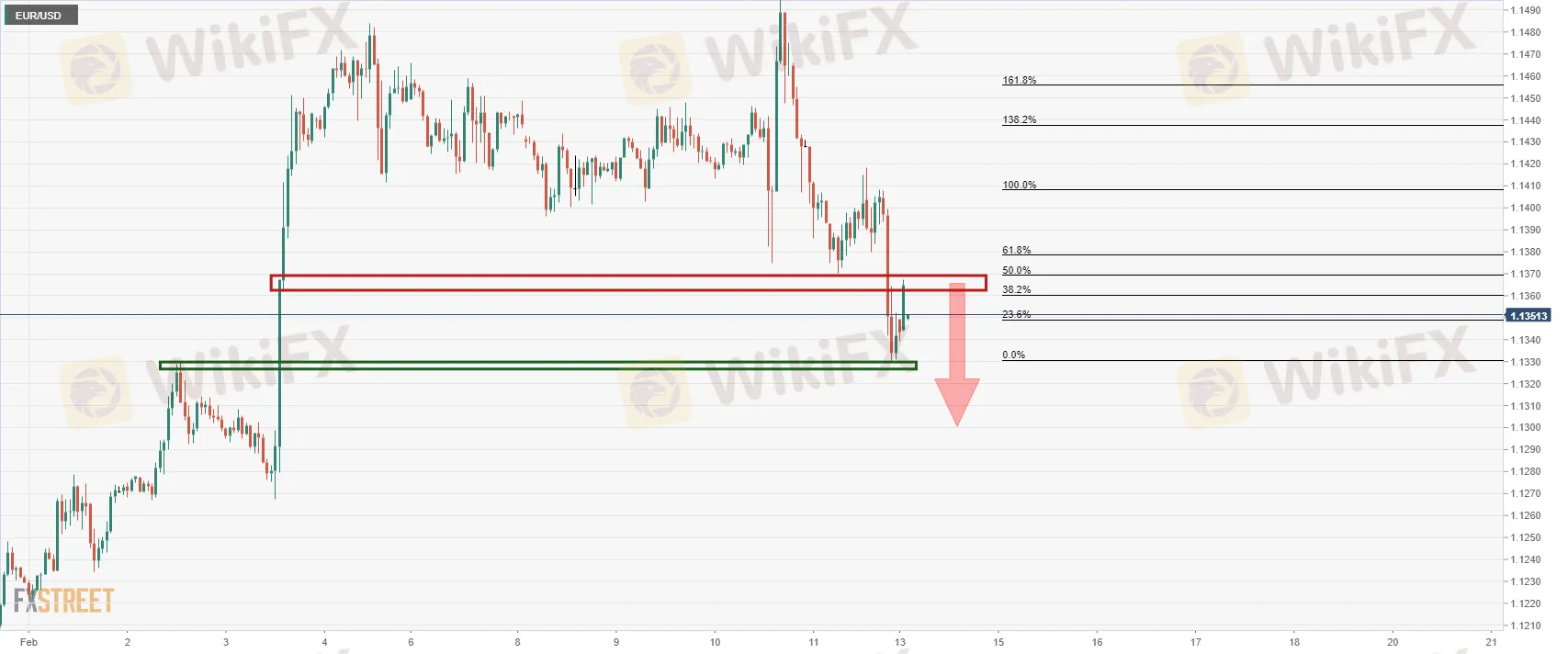简体中文
繁體中文
English
Pусский
日本語
ภาษาไทย
Tiếng Việt
Bahasa Indonesia
Español
हिन्दी
Filippiiniläinen
Français
Deutsch
Português
Türkçe
한국어
العربية
EUR/USD bears are moving in with a focus on 1.1305, Russia invasion risk weighing
Abstract:EUR/USD is bleeding the initial gains for the day as risk appetite drifts off with the major Asian indexes printing in the red. EUSCI's broadest index of Asia-Pacific shares outside Japan dropped 0.2%, while Japan's Nikkei lost 2.5%. At 1.1353, the euro is now flat on the day to the US dollar after correcting a significant portion of Friday's sell-off to a high in the 1.1369's.

EUR/USD bears are moving in from the hourly the 38.2% ratio.
1.1305 serves as potential support below current lows.
Russia and central bank sentiments are the driving forces.
The start of the week is jittery following alarmingly high US inflation readings last week combined with risks of a Russian invasion of Ukraine. US president Joe Biden and Russian president Vladimir Putin talked by phone for an hour on Saturday in what is widely seen as a last-ditch effort to fend off a Russian invasion of Ukraine. The call, however, brought “no fundamental change” to the worsening crisis although the US and Russia have agreed to stay engaged in the coming days according to a senior US official, briefing reporters. The official also told reporters that ''Russia may decide to proceed with military action anyway.''
Meanwhile, there is speculation that the Federal Reserve might raise rates by a full 50 basis points in March with chatter about an emergency inter-meeting hike. That was spurred in part by the timing of a closed Fed Board meeting for Monday, though the event has been presumed routine.
However, not all Fed members are singing from the same hymn sheet. While hawk and St. Louis Fed James Bullard advocated for a 50bps hike at the March meeting, San Francisco Fed President Mary Daly played down the need for a half-point move in an interview on Sunday. Daly argued that being too “abrupt and aggressive” on policy could be counter-productive. Fed President James Bullard will be in focus later on Monday, given his recent calls for a more aggressive stance at the Fed, signifying 100 basis points of tightening by June.
US FOMC minutes / Retail Sales in focus
As for other events in the week, the Federal Open Market Committee meeting minutes will be released and traders will be on the lookout for discussions regarding near-term policy plans. Analysts at TD Securities explained that the market will be paying particular attention to plans for balance sheet normalization steps, following the release of the normalization “principles” in Jan.
''The minutes might seem stale, however, given the recent strength in macro data,'' the analysts added. Markets will then look to US Retail Sales where an improvement on December's sharp decline could be supportive to the US dollar.
EUR/USD technical analysis

Disclaimer:
The views in this article only represent the author's personal views, and do not constitute investment advice on this platform. This platform does not guarantee the accuracy, completeness and timeliness of the information in the article, and will not be liable for any loss caused by the use of or reliance on the information in the article.
Read more

The president of @Liberland, @Vít Jedlička come on stage, dialogue on trading security.
The 2025 WikiEXPO Hong Kong Station is about to grandly open. the president of @Liberland, @Vít Jedlička come on stage, dialogue on trading security.

Countdown: 1 day.WikiEXPO2025's first stop, Hong Kong, is about to open.
⏰ Countdown: 1 day. WikiEXPO2025's first stop, Hong Kong, is just tomorrow. Focus on transaction security and explore new investment opportunities. ???? Get ready to start now. See you tomorrow.

JustForex vs JustMarkets: A Comprehensive Comparison in 2025
Selecting the right forex broker can make the difference between trading success and frustration for most investors, especially retail investors. As retail traders gain unprecedented access to global markets, the choice between platforms like JustForex and JustMarkets becomes increasingly significant. Both brokers offer some shining features within the forex and CFD trading space, but their approaches differ in some areas.
Vault Markets Review 2025: Live & Demo Accounts, Withdrawal to Explore
Vault Markets, a South African-based broker, has attracted much attention in recent days, particularly within its region. This online broker only offers access to focused trading opportunities on Indices, Currencies, Energies, and Metals, yet it shines on low minimum deposits plus various bonus programmes, which would encourage more investors, especially beginners, to trade with a small budget. However, Vault Markets operates outside of the authorized scope, so we don't consider it solid to trade with.
WikiFX Broker
Latest News
Enlighten Securities Penalized $5 Million as SFC Uncovers Risk Control Failures
Why Are Financial Firms Adopting Stablecoins to Enhance Services and Stability?
Experienced Forex Traders Usually Do This Before Making a Lot of Money
Octa vs XM:Face-Off: A Detailed Comparison
When High Returns Go Wrong: How a Finance Manager Lost RM364,000
Bridging Trust, Exploring Best—WikiEXPO Hong Kong 2025 Wraps Up Spectacularly
Interactive Brokers Expands Crypto Trading with Solana, XRP, Cardano, and Dogecoin
Fidelity Investments Explores Stablecoin Innovation in Digital Assets Sector
Why More People Are Trading Online Today?
SEC Ends Crypto.com Probe, No Action Taken by Regulator
Currency Calculator







